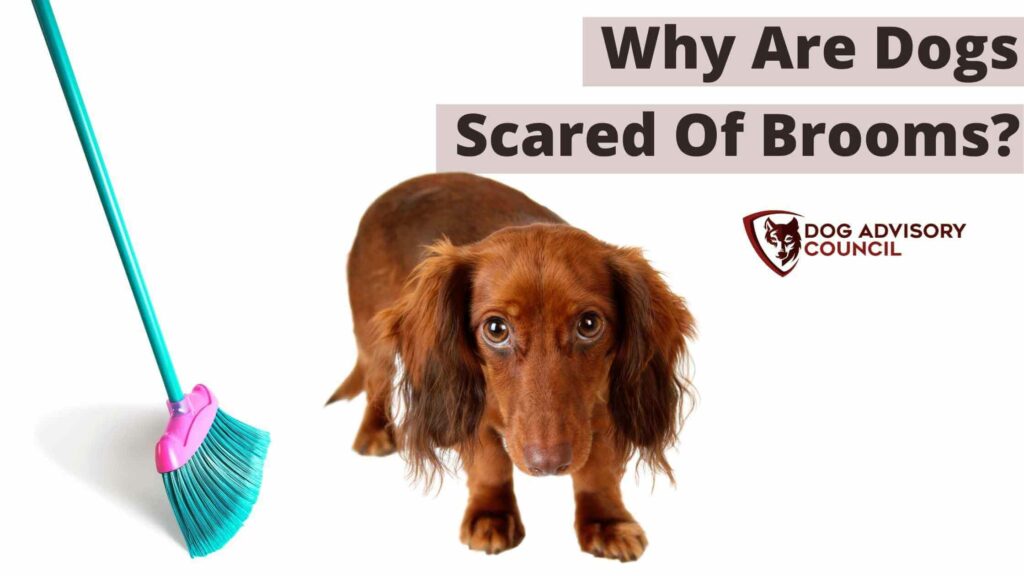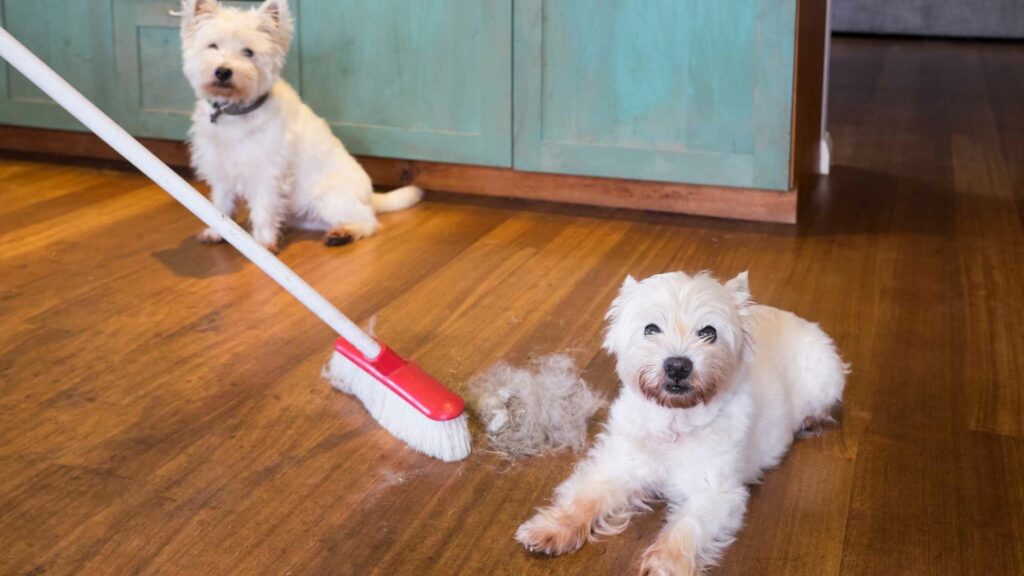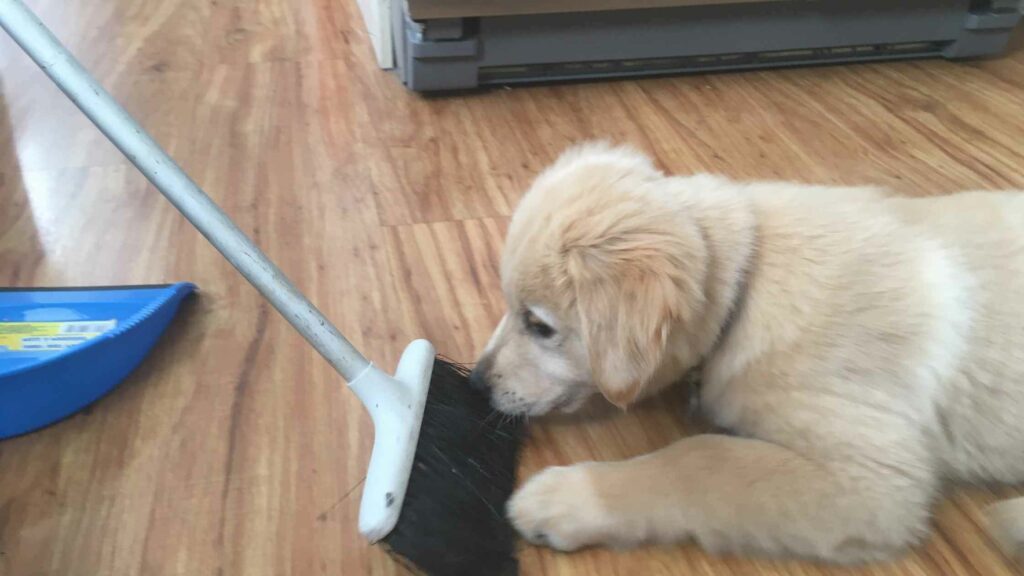
Is there a reason your dog freaks out when you take the broom out of its closet? Actually, yes. Here’s why are dogs scared of brooms. Take a look at what you need to know below!
Dogs are not actually scared of brooms but reacting to a genetic tendency to be uncomfortable with brooms. This is a common trait, with 40-60% of dogs reacting this way to brooms of all kinds, regardless of their background. This biological trait is in herding dogs and can’t be changed, but you can train your dog to modify their behavior. Dogs can be scared of brooms if they aren’t socialized, though. However, this is different from biological instinct.
Reasons for a dog to be scared of brooms
Let’s take a closer look at all these reasons in detail so that you can get more comfortable with what is going on when your dog panics at the broom coming out of the closet! The main categories are:
- Herding mentality
- Lack of socialization
- A sudden change in the environment
Herding mentality
This is what we were talking about above as far as the biological impulse. If your dog is a herding dog, their job — biologically speaking — is to get their “charges” to listen to them. They do this by corralling them together and using their authority. They expect the broom to move a certain way, and a broom doesn’t do that. So, it confuses your dog, and they don’t understand why their focused and hard-working efforts are going unnoticed by this broom.
Many herding dogs will instinctively try to corral the unruly and mischievous broom (as well as the mop, vacuum cleaner, and dusting wand) to do as they say. When the broom doesn’t respond properly, it can make your dog anxious since this problem is new to them. They don’t really know what to do or how to do it. This can cause real, severe anxiety in your dog!
It’s hard for us to understand because we know that a broom is harmless and controlled by us. But dogs see brooms as animated objects that will take on a life of their own.
A dog that doesn’t have proper socialization skills won’t be able to understand brooms, either, which also causes anxiety. The reason vets, breeders, and every professional in dogs recommend lots of socialization is because it makes your dog experienced and strong in an emotional and mental sense. The more that your dog experiences, the braver that they’ll be. If your dog never gets out, or they are not exposed to new experiences at all, they won’t be able to understand the broom.
Socialization also would include exposure to new things in your/their home, since new experiences will always be a support for them having a better understanding — no matter where they are! Regular exposure to new things throughout their life is an excellent technique for helping them have healthy anxiety control.
A sudden change in the environment
Your dog will get comfortable in their environment. They’ll be used to going to their regular places and taking on new experiences, but they’ll more-or-less settle into a schedule. So, if you decide to sweep the floor one day and just grab the broom and start sweeping (as many of us do), it will confuse and even scare your dog.
After all, the broom lives in the broom closet, comes out suddenly, whips around the house, “ignores” your dog’s commands, and then disappears. Meanwhile, you seem totally fine about the entire experience and are even laughing at your dog, which your dog will find confusing.
When you see it from their point of view, this sudden change in environment will be very unsettling and even frustrating for them since they don’t understand where this frantic broom-creature is coming from or going.
To us, a broom is harmless and no big deal, but your dog understands it only as an animated object that is rather disobedient and very good at disappearing.

How do you desensitize a dog to a broom?
If you want to make sure that your dog is as comfortable as possible around the scary broom. In that case, you’ll have to focus on desensitizing him. This process involves showing your dog that the broom is nothing to be scared of and then gradually helping them be around the broom without a fear response. Here are the steps to follow:
- Understand why he is behaving the way he is
- Bring the dog and broom together safely
- Pair checking out the broom with positive things
- Introduce your dog to its movements
- Respect your dog’s comfort
Understand why he is behaving the way he is
As mentioned above, there are a few approaches to why your dog could be acting as they are. Understand which of them are the main factors and use those to adjust your approach to how you’re going to help retrain your dog. Not only will this help you develop the right plan to do so, but it also will help to understand where your dog is coming from.
Bring the dog and broom together safely
When desensitizing, you must bring the trigger and your dog together. In this case, you’ll get them used to the broom in small amounts, bearing their panic in mind. Here’s an example of how that could look:
Step one: With your dog sitting patiently and relaxed, slowly bring the room out of the closet. Rest the broom against the door or nearby, and then go to your dog. Your dogs may run around in anxiety. If so, call him back and tell him “good boy” or “sit,” etc. Keep calm and keep going by calling him to you and getting him to sit. When he does so, reward him with a treat and give him some TLC.
You’ll want to do this a few times and repeat it until he no longer has anxiety when the broom comes out and sits against the door.
Step two: When your dog hits this critical milestone, you’ll want to start the next step in the desensitization process. This involves bringing your dog over to the broom. It’s essential to bring your dog to the broom and not the other way around. Your dog should feel in control the entire time.
Encourage your dog to come over with you to the broom. Offer them a treat as an incentive, but make sure they come over on their own to check it out. Reward them for this, and then allow them to check out the broom and sniff it without it moving or shifting.
Step three: Get them used to the broom being around even without your encouraging them to do so. Your dog will most likely start out not going near it. But eventually, curiosity will get to them, and they’ll start to check the broom out. They might bark and try to “provoke” the broom to attack. But when they see that’s not going to happen, they might grow bored and no longer pay the broom attention.
This is, of course, the main point. This helps separate the fear from the object, and that will support your dog’s mental growth.
Pair checking out the broom with positive things
When you’ve dealt with the basic desensitization, you can help condition the new positive response with the use of treats and positive things. Your dog will begin associating positive things with the broom, which will help them lose their anxiety. It won’t cure it, but it will help lessen its severity.
Introduce your dog to its movements
When your dog adjusts to the stationary broom as much as they’re going to, you’ll need to show them the movements. This can cause them to regress a bit, but just combine the positive reinforcement and stay calm. Use slow, easy movements to sweep and encourage your dog to stay calm and enjoy their treat.
You can also blend a special kind of beloved t react with your sweeping. For example, a chew toy they love or a nice bone they can work on while you sweep. It’ll ease their anxiety and help them see positive reinforcement with the sweeping. Reserve that treat, whatever you choose, for sweeping sessions only. If you give it to your dog on another occasion, it may not work later with the broom!
Respect your dog’s comfort
Most importantly, you need to respect your dog’s comfort regarding desensitization and comfort around the actual broom. Your dog may never be anything better than uneasy around the broom, and forcing your dog to achieve more is pointless. Respect your dog and meet them where they are for their comfort with the broom.
Perhaps they are comfortable with it while stationary but hate when it moves. If your only option is to put your dog outside in the yard while you sweep to ease their mind, then that’s not a failure — it’s kindness.

How to introduce a dog to a broom
If you are reading this preventatively and want to know how to properly introduce your dog to a broom to minimize this instinct as much as possible, consider this your introduction guide:
- Bring the broom out and encourage your dog to check it out
- Praise and treat them when they do
- Show them how it moves (with slow and gentle movements) and continue to praise them
- NEVER chase them or bat at them with the broom (even jokingly)
- Do this each time that the broom comes out
- Consider storing the broom somewhere accessible rather than in a cupboard
The goal is to help your dog see that the broom is a positive thing or, at the very least, not a negative thing. This will help reduce their instinctive uncertainty about the broom.
Troubleshooting broom problems with your dog
There are some common problems when it comes to dogs and brooms. Here are some of the most common questions and answers!
- My dog attacks my broom; what do I do?
- If my dog won’t adjust to my broom, should I get a new one?
- Does the type of broom make a difference?
- Do dogs react the same way to mops and vacuum cleaners?
- Is it possible my dog is playing with the broom?
My dog attacks my broom; what do I do?
You should work on desensitizing your dog to the broom and work on developing a positive bond with the broom. They trust you, so use your bond with them to do this through the steps above. Be patient; it might take time!
If my dog won’t adjust to my broom, should I get a new one?
Sometimes getting a new broom can help, but you’ll most likely want to consult a professional for more advice or help or consider putting your dog outside while you sweep. It’s your call based on how your dog’s actually acting, even with desensitization.
Does the type of broom make a difference?
The type of broom shouldn’t make a difference to how your dog reacts, though your dog may suddenly react stronger to a new broom if it looks different enough from the one that you previously had. For example, you replace a classic household broom with a push broom or a flat microfiber one.
Do dogs react the same way to mops and vacuum cleaners?
Some dogs react the same way to mops and/or vacuums, and others don’t. It depends on your dog and their socialization!
Is it possible my dog is playing with the broom?
Absolutely! Some dogs will want to “help” by playing with the broom to “keep it under control” while you sweep. Again, remember that dogs don’t understand that you are making the broom move! This can be very funny for us humans!
In brief
Your dog is most likely scared of brooms but is acting instead against a genetic tendency to want to herd the broom. Many herding dogs are anxious around the free-thinking brooms because their herding traits aren’t working or impacting them.
While you can’t change this instinct, you can modify their behavior by working on desensitizing them and helping them learn how to react a bit more calmly toward the broom.
Dogs and brooms don’t always go hand in hand, but it’s reassuring to know that you can do a few things to help your dog enjoy more comfort as they spend more time around brooms without an all-out panic attack or war.
Know someone that is struggling with a dog vs. a broom? If so, consider sharing this with them!
